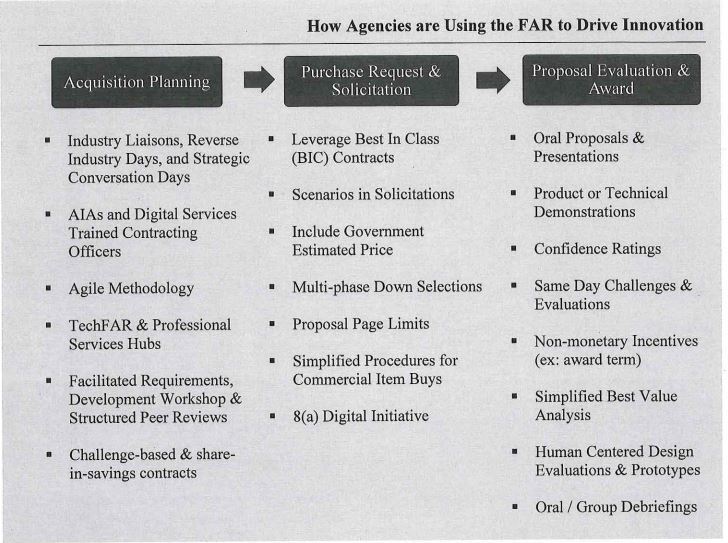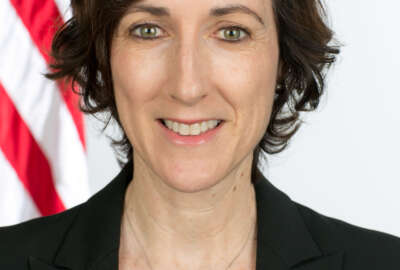
OFPP outlines 10 acquisition innovations agencies can use today
In OFPP’s fourth version of its myth busters series, agencies can tell acquisition innovation fact from fiction and receive examples where those efforts are...
Best listening experience is on Chrome, Firefox or Safari. Subscribe to Federal Drive’s daily audio interviews on Apple Podcasts or PodcastOne.
Innovation is one of those terms in federal procurement that gets thrown around a whole lot. When is an agency or organization innovative? What stops agencies from trying something new or different when it comes to buying goods and services?
The Office of Federal Procurement Policy is trying to answer those questions and debunk some myths about acquisition innovation in its 4th version of its Myth busters series.
Lesley Field, the deputy administrator for OFPP, said the new memo is part of an effort to break down the barriers to innovation that agencies, auditors and mostly time have built up over the past 20 years.

“The reason we focused on the misconceptions and facts on innovative practices was to get at that complex base where we have a lot of folks who need to spend their time and talent figuring out how to solve our hard problems,” Field said in an interview with Federal News Network. “These are things lifted from the Federal Acquisition Regulations (FAR). There’s no new guidance. There’s no new policy. These are existing authorities that contracting officers can use out of the box.”
The idea that the memo highlights existing authorities and includes use cases has been a standard with the myth busters memos. In each of the previous three iterations, OFPP has tried to ensure it not only “busted the myth,” but provided examples or best practices.
This is now the fourth myth busters memo since 2011. The others addressed industry and agency communications, including debriefings discussions during market research for a request for proposals.
In this latest myth busters memo, OFPP asks CFO Act agencies to address a long standing challenge with these memos ensuring industry and contracting officers are aware and understand what the memo is telling them they can do.
OFPP directed each agency to publicly name an industry liaison “to serve as a conduit among acquisition stakeholders and promote strong agency vendor communication practices.”
At the same time, Field said OFPP started an “in-reach” campaign because they have found there is an awareness gap with contracting officers. Over the last three memos, this awareness gap issue has been a major hurdle standing in the way of the program’s success.
Field said OFPP and the Chief Acquisition Officer’s Council are planning webinars with federal procurement experts, an Acquisition Gateway University program and to figure out how to further educate contracting officers and contracting officer representatives (CORs) about the acquisition facts.
OFPP is depending on the CAOs, acquisition innovation advocates and other leaders to share and trumpet the myth busters memo.

Soraya Correa, the chief procurement officer at the Homeland Security Department, said she emailed the memo to her entire acquisition community.
“The other thing I do is I take the opportunity during my procurement community townhall, which I’m having another one next week, I’ll discuss the memo and why it’s important to keep these lines of communications open, and I encourage and support doing these things. Believe it or not, the word does get out because I’m talking directly to the 1,400 people or so that are out there across the DHS landscape.”
Correa said she also talks with other CXO leaders, including the general counsel’s office.
“I try to include the lawyers in all the activities that we engage in. Whether it’s our strategic industry conversations that I host every year or reverse industry days or our acquisition innovation roundtables and even [Procurement Innovation Lab (PIL)] boot camps, I’m happy to say our attorneys are participating in these activities. They hear what I have to say and they understand what we are trying to do,” she said. “What we have to do is include them in the conversation, by bringing them in to help them understand what we are trying to do. Instead of saying to them, ‘can I do this?’ Maybe the question is ‘how can I do this?’ Change the conversation a little bit with the lawyers, and you may get a different outcome.”
Field said OFPP also recognizes the need to bring procurement attorneys into the discussion. She said her office is sharing the myth busters memo through the procurement attorneys roundtable, an informal gathering of acquisition lawyers used as a sounding board, to ensure they understand what’s possible.
“The other thing we did with myth busters is attach a tear-sheet for the first three myth busters guidance so folks can take it and hand it to someone and say, ‘look OFPP is saying we can use these practices,’” she said.
DHS has used its PIL to demonstrate many of these concepts, including Myth #7: using product demonstrations before an agency buys—the show me, don’t tell me approach—and Myth #1: using innovative business strategies.
Correa said the memo’s message is clear: Agencies need to do a better job engaging with industry and it’s good to be transparent and open.
“We will create better and more effective processes when we do that,” Correa said in an interview with Federal News Network. “I can tell you my experiences has been the more we engage with industry here, the better solutions we are getting. We believe industry finds us to be a little more transparent than in the past.”
Field said one of the biggest myths she hopes the memo debunks is the one that says the FAR is complex and that’s why there are long lead times.
She said while there are complexities in the FAR, the agencies have a lot of authorities and flexibilities that they can use to get industry engagement early and often.
“The one thing I really like about this is we are going to make this a living document. This isn’t static. We are going to add examples, try to connect folks who are working on similar kinds of things and put resources up on the Acquisition Gateway so that contracting officer, program managers, lawyers and everyone involved in the process understands what they can do,” she said. “DHS and a lot of the other agencies have had great success with some of these practices. It’s reduced the burden on vendors. It’s helped us meet a lot of our goals.”
Copyright © 2025 Federal News Network. All rights reserved. This website is not intended for users located within the European Economic Area.
Jason Miller is executive editor of Federal News Network and directs news coverage on the people, policy and programs of the federal government.
Follow @jmillerWFED
Related Stories

OFPP dispels 8 more agency, vendor communications myths





